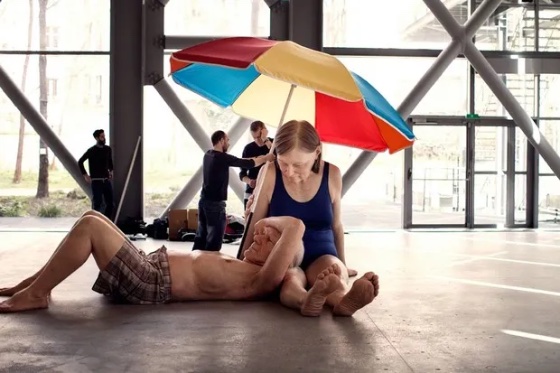Ron Mueck’s “Couple under an Umbrella” (2013) being installed at the Fondation Cartier. Photo © Thomas Salva
Every so often, an exhibition emerges that offers ideas and images that nourish the mind for years. “Ron Mueck,” which just opened at the Fondation Cartier in Paris, is one of them, marrying almost inhuman artistic skill with a very graspable, and very moving, project.
Ron Mueck started his career as a puppeteer-model maker for children’s television programs before opening a prop-building company in London. Now devoted full-time to fine art, he produces photorealistic sculptures of human beings, either in gigantic proportions or in varying degrees of miniature. He made his name with the 1997 piece “Dead Dad,” a prostrate rendition of the artist’s deceased father, featuring some of Mueck’s own hair.
The exhibition at the Cartier Foundation does not include this piece, but has much else to offer. The first piece, “Couple under an Umbrella,” is visible even before one sets foot inside the glass building: a gargantuan model of an elderly couple relaxing under a parasol. The detail is mind-blowing – we make out varicose veins, sunburn flowering delicately on the male’s pot belly, flesh bulging around the gold of a now-tight wedding ring. Though the couple is supersized, they are not menacing and exude such tenderness toward each other that the visitor is caught off-guard. These are gentle giants.
In the next room, we discover a gigantic plucked chicken hanging eerily from the ceiling (“Still Life”), a naked woman bent backward under the weight of the load of branches she carries (“Woman with Sticks”) and a mother glumly holding shopping bags with her newborn baby’s head poking up from under her coat (“Woman with Shopping”). Of these, the sculpture of the mother is the most striking – partly for its realism, which with Mueck is somehow impossible to get used to, but also because of the palpability of the bond between parent and child. The contents of her shopping bags, too, are beguiling, rendering everyday British foodstuffs, like baked beans and Yorkshire tea, to a smaller scale.
With its tall ceilings and light-saturated interior, the Fondation Cartier is one of Paris’s great art spaces. Its broad modern proportions complement Mueck’s work perfectly, sparking a dialogue between the sculptures and the building’s architecture. The canniness of the curator is also obvious, particularly so downstairs, where a sculpture of a man floating on an inflatable beach bed is hung on a wide blue wall so that he seems to be in the middle of a large vertical pool. Mueck’s famous “Man in a Boat” is also down here, recalling the rower in Philip Pullman’s novel The Amber Spyglass, whose Charon-like job it is to ferry the deceased over to the world of the dead.
Also on show is a documentary by Gautier Deblonde, who filmed for 18 months in Mueck’s London studio. Though unusually long for an exhibition film (52 minutes), the documentary answers all, or nearly all, the questions that arise after seeing Mueck’s pieces. Apart from the occasional sputter of radio or snatch of conversation, the film is silent, revealing the artist and his assistants at work on their creations. The creative process is absorbing – we see hair being sewn into scalps, moles being applied onto skin, veins being wiggled onto tennis-ball-sized eyeballs. It is gripping, but also subtle, respectful and quietly witty filmmaking.
The film demonstrates the surprising truth about Mueck’s work: unlike Duane Hanson’s eerily realistic figures, which were molded from live models, Mueck’s sculptures, accurate in every tiny detail except their proportions, are made from scratch, with the artist starting out by sculpting the figures in clay by hand.
Mueck’s exhibitions are few and far between, and with the amount of craftsmanship that goes into each piece, it is hardly surprising. Rare event or not, however, this is a show that demands to be seen.
Favorite
